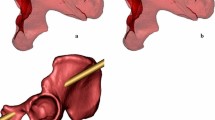Abstract
Introduction
Percutaneous retrograde screw fixation for acetabular fractures is a demanding procedure due to the complex anatomy of the pelvis and the varying narrow safe bony corridors. Limited information is available on optimal screw placement and the geometry of safe zones for screw insertion in the pelvis.
Methods
Three-dimensional reconstructions of 50 consecutive CT scans of polytrauma patients (35 males, 15 females) were used to introduce three virtual CAD bolts (representing screws) into the anterior column (superior ramus of the pubic bone), posterior column (the ischial bone) and the supraacetabular region, as performed during percutaneous screw fixation. The three-dimensional (3D) position of these screws was evaluated with a computer software (MIMICS) after virtual optimal insertion. The 3D position, the narrowest zone and the distance to the hip joint of the two columns and the supraacetabular region were defined.
Results
The mean maximal screw length for the three virtual screws measured between 107.4 and 148 ± 18.7 mm. The narrowest zone of the pelvic bone (superior pubic ramus) had a width of 9.2 ± 2.4 mm. The average distances between the bolts and the hip joint were 3.9 and 19.4 ± 7.4 mm. For the anterior column (superior pubic ramus) screw, the mean lateral angle to the sagittal midline plane was 39.0 ± 3.2° and the mean posterior angle to the transversal midline plane was 15.1 ± 4.0°. The mean supraacetabular screw angles measured 22.4 ± 3.4° (medial), 35.3 ± 4.6° (cranial) and the mean angles for the ischial screw were 12.0 ± 5.4° (posterior) and 18.4 ± 4.0° (lateral).
Conclusions
The zones for safe screw positioning are very narrow, making percutaneous screw fixation of the acetabulum a challenging procedure. The predefined angles for the most frequently positioned percutaneous screws may aid in preoperative planning, decrease operative and radiation times and help to increase safe insertion of screws.





Similar content being viewed by others
References
Carroll EA, Huber FG, Goldman AT, Virkus WW, Pagenkopf E, Lorich DG, Helfet DL (2010) Treatment of acetabular fractures in an older population. J Orthop Trauma 24(10):637–644
Ferguson TA, Patel R, Bhandari M, Matta JM (2010) Fractures of the acetabulum in patients aged 60 years and older: an epidemiological and radiological study. J Bone Joint Surg Br 92(2):250–257
Mears DC (1999) Surgical treatment of acetabular fractures in elderly patients with osteoporotic bone. J Am Acad Orthop Surg 7(2):128–141 Review
Vallier HA, Cureton BA, Ekstein C, Oldenburg FP, Wilber JH (2010) Early definitive stabilization of unstable pelvis and acetabulum fractures reduces morbidity. J Trauma 69(3):677–684
Bates P, Gary J, Singh G, Reinert C, Starr A (2011) Percutaneous treatment of pelvic and acetabular fractures in obese patients. Orthop Clin North Am 42(1):55–67
Starr AJ, Jones AL, Reinert CM, Borer DS (2001) Preliminary results andcomplications following limited open reduction and percutaneous screw fixation of displaced fractures of the acetabulum. Injury 32(Suppl 1):SA45–SA50
Starr AJ, Reinert CM, Jones AL (1998) Percutaneous fixation of the columns of the acetabulum: a new technique. J Orthop Trauma 12(1):51–58
Kaempffe FA, Bone LB, Border JR (1991) Open reduction and internal fixation of acetabular fractures: heterotopic ossification and other complications of treatment. J Orthop Trauma 5(4):439–445
Shahulhameed A, Roberts CS, Pomeroy CL, Acland RD, Giannoudis PV (2010) Mapping the columns of the acetabulum—implications for percutaneous fixation. Injury. 41(4):339–342
Attias N, Lindsey RW, Starr AJ, Borer D, Bridges K, Hipp JA (2005) The use of a virtual three-dimensional model to evaluate the intraosseous space available for percutaneous screw fixation of acetabular fractures. J Bone Joint Surg Br 87(11):1520–1523
Zhang YZ, Lu S, Chen B, Zhao JM, Liu R, Pei GX (2011) Application of computer-aided design osteotomy template for treatment of cubitus varus deformity in teenagers: a pilot study. J Shoulder Elbow Surg 20(1):51–56
Pichler W, Windisch G, Schaffler G, Heidari N, Dorr K, Grechenig W (2010) Computer-assisted 3-dimensional anthropometry of the scaphoid. Orthopedics 33(2):85–88
Pichler W, Windisch G, Schaffler G, Rienmüller R, Grechenig WJ (2009) Computer tomography aided 3D analysis of the distal dorsal radius surface and the effects on volar plate osteosynthesis. Hand Surg Eur 34(5):598–602
Mouhsine E, Garofalo R, Borens O, Wettstein M, Blanc CH, Fischer JF, Moretti B, Leyvraz PF (2005) Percutaneous retrograde screwing for stabilisation of acetabular fractures. Injury 36(11):1330–1336
Gay SB, Sistrom C, Wang GJ, Kahler DA, Boman T, McHugh N, Goitz HT (1992) Percutaneous screw fixation of acetabular fractures with CT guidance: preliminary results of a new technique. AJR Am J Roentgenol 158(4):819–822
Routt ML Jr, Simonian PT, Grujic L (1995) The retrograde medullary superior pubic ramus screw for the treatment of anterior pelvic ring disruptions: a new technique. J Orthop Trauma 9(1):35–44
Routt ML, Nork SE, Mills WJ (2000) Percutaneous fixation of pelvic ring disruptions. Clin Orthop Relat Res 375:15–29
Parker PJ, Copeland C (1997) Percutaneous fluoroscopic screw fixation of acetabularfractures. Injury 28(910):597–600
Ochs BG, Gonser C, Shiozawa T, Badke A, Weise K, Rolauffs B, Stuby FM (2010) Computer-assisted periacetabular screw placement: Comparison of different fluoroscopy-based navigation procedures with conventional technique. Injury 41(12)
Vioreanu MH, Mulhall KJ (2011) Intra-operative imaging technique to aid safe placement of screws in percutaneous fixation of pelvic and acetabular fractures. Acta Orthop Belg 77(3):398–401
Author information
Authors and Affiliations
Corresponding author
Rights and permissions
About this article
Cite this article
Puchwein, P., Enninghorst, N., Sisak, K. et al. Percutaneous fixation of acetabular fractures: computer-assisted determination of safe zones, angles and lengths for screw insertion. Arch Orthop Trauma Surg 132, 805–811 (2012). https://doi.org/10.1007/s00402-012-1486-7
Received:
Published:
Issue Date:
DOI: https://doi.org/10.1007/s00402-012-1486-7




